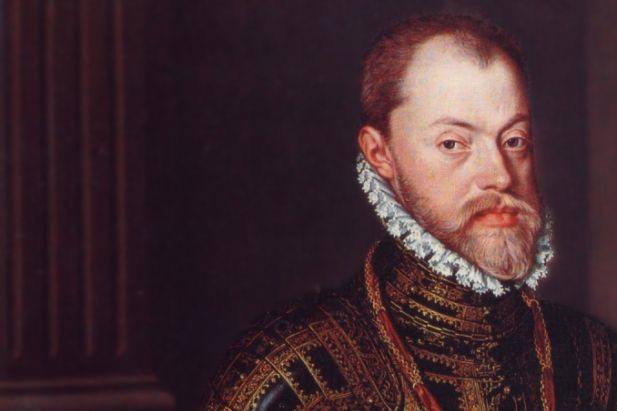


| |
Philip II of Spain   
Philip, son of Charles, was now count of Holland and king of Spain. He went to England and married the princess, generally known as "Bloody Mary," and prevailed upon her and the government of England to declare war against France. He assembled in the Netherlands an army of nearly 50,000 men, 12,000 of whom were cavalry. The French army was in Italy, so Philip, in 1558, quickly laid siege to the town of St. Quentin. Here he was reenforced by 3,000 English soldiers.
The French constable, Montmorency, marched with his army to help the garrison, and a battle ensued outside the city. Count Egmont, who was in command of the splendid Dutch cavalry, attacked the enemy in flank, and the French were defeated. Many noblemen of France were killed, and all the artillery and baggage and thousands of prisoners were taken. Egmont became the hero of the hour and the idol of the army. Another battle was fought at Gravelines. There, Egmont again, by his boldness of attack, won great glory. The ten English vessels that had arrived in good season also helped to decide the victory. To the surprise of the Dutch, the war came suddenly to an end by the treaty of Cambrai. They were not happy at this, and thought things were going too fast. They believed that Granvelle, bishop of Arras, had persuaded the Spanish and French kings to bury political quarrels, in order to unite their forces and begin a religious war to put down the Huguenots in France and the Calvinists in the Netherlands.
Their suspicions were soon confirmed; for the French king let out the secret. William of Orange had been sent by Philip, as one of his hostages, to remain with the king of France. One day while out hunting, the king, supposing that, as a matter of course, William knew all about the reason why peace had been so quickly made, told him that it was the royal purpose to put all the heretics to death. Instead of showing great surprise, talking about it, or asking further questions, the young nobleman kept perfectly quiet. On account of this episode, although he was a very genial and social man, and was able to talk in several languages, he was called by some William the Silent, though the name has been used chiefly since his death.
When the startled Dutchmen learned that King Philip had asked the Pope to have 14 new bishoprics erected in the Netherlands, their worst fears were realized. This meant that 14 new rulers, with great political power, who could put men in prison, and even torture and kill them, because they might hold different opinions from Philip and the Pope, would be appointed. Furthermore, the large salaries of the bishops, and those of their hangers-on, would have to be paid out of the pockets of the people, as well as from the funds of the abbeys. Neither the parish priests nor the nobles liked the new movement, while the people felt certain that the whole thing was meant to increase the power of the Inquisition, which had already caused the death of many innocent people.
The Dutch were further angered because Philip had Spanish nobles about him, who looked with contempt upon natives of Holland. When they heard that to the Spanish soldiers already in the country were to be added 4,000 more, the Dutch were in real alarm. As King Philip would soon sail for Spain, the people were very anxious to know who would be the king's regent, to rule them in his absence. Among the nobles two young men were prominent: one was Count Egmont, very handsome and popular, and the soldier's ideal; the other was William of Orange, wiser and with far greater abilities as a civil ruler.
| |
|















